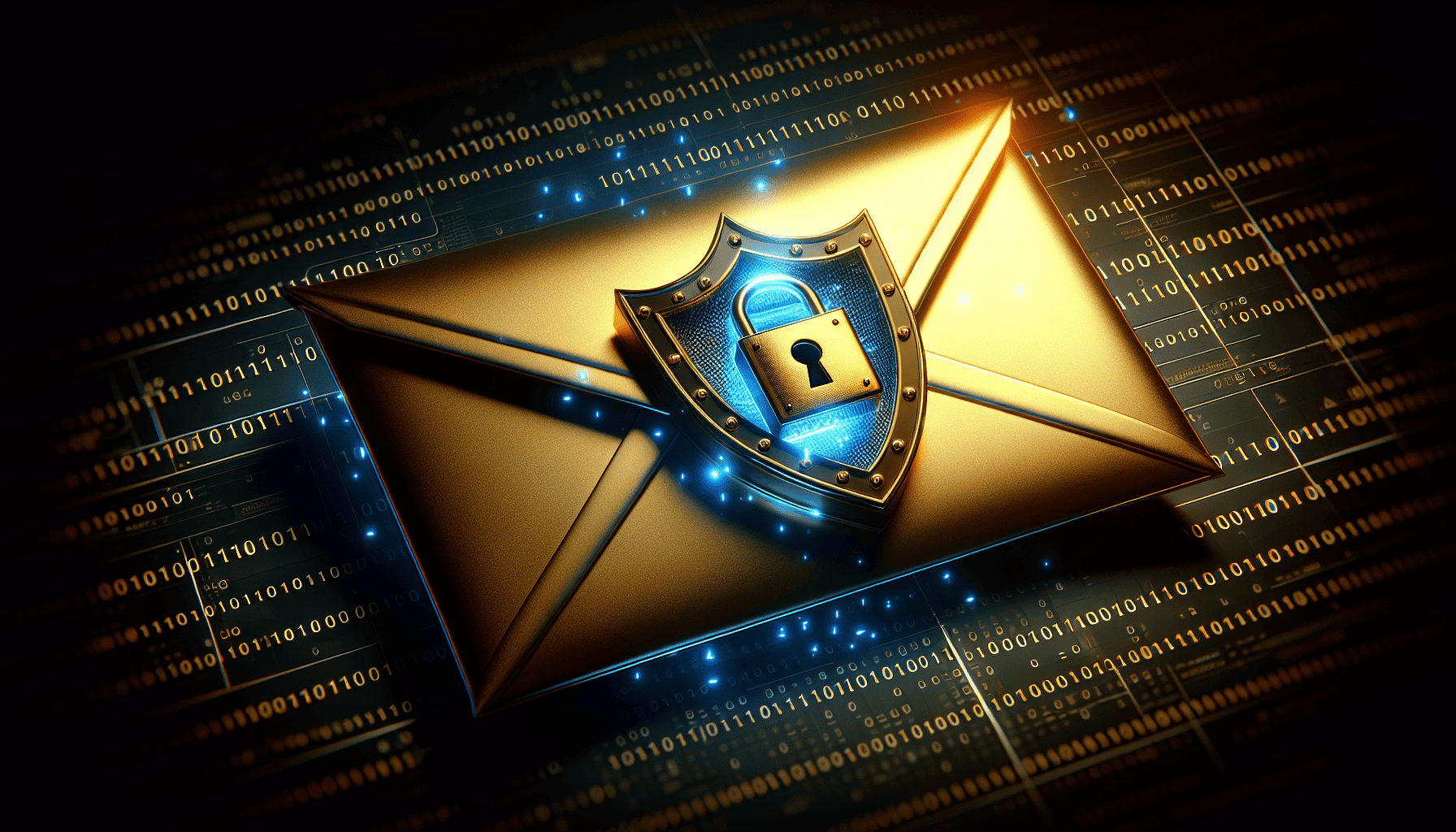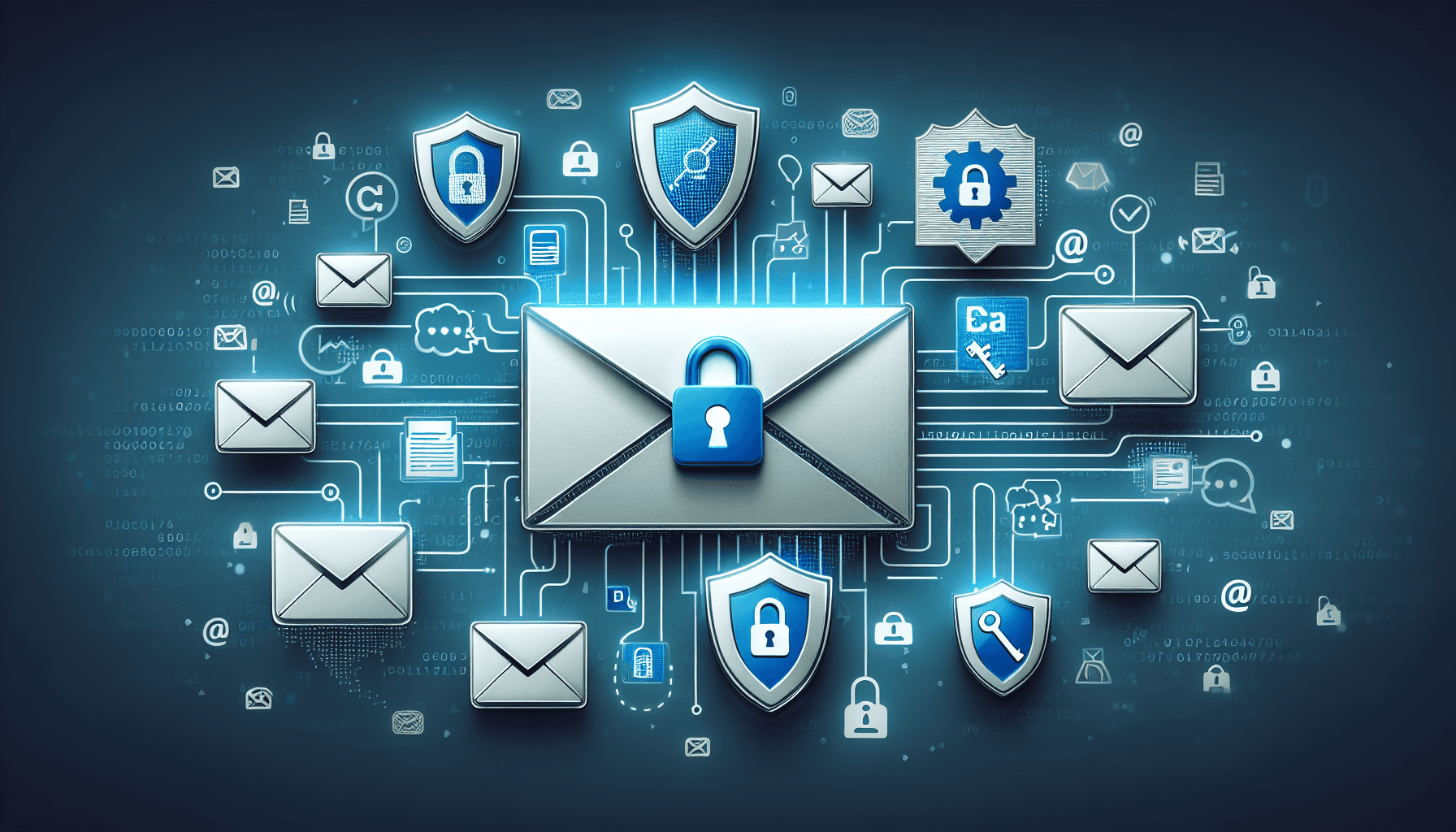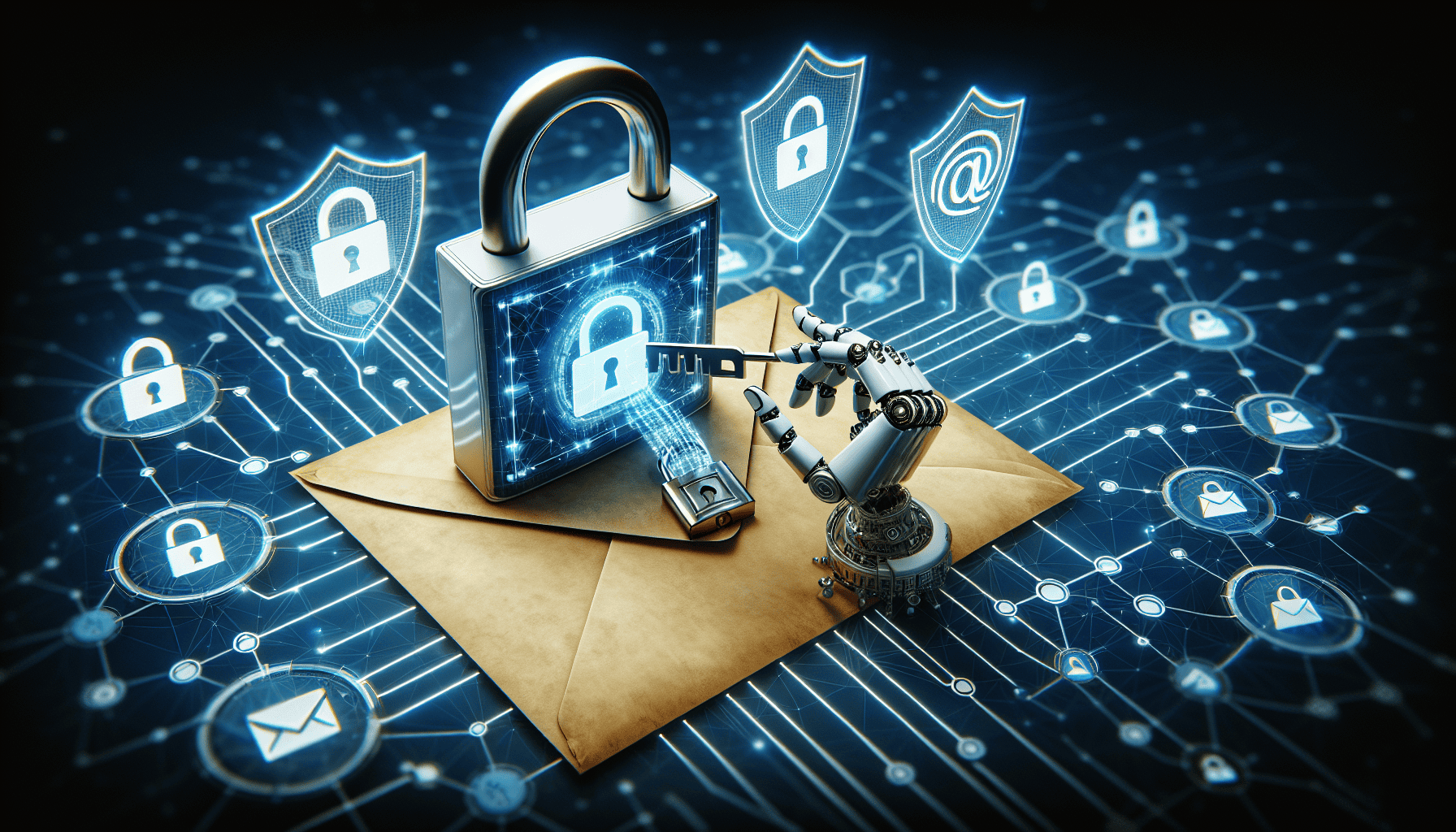Looking to encrypt email Outlook? This article delivers a practical roadmap for securing your electronic communications within minutes. You’ll learn not only the steps to encrypt emails but also how to handle certificates and troubleshoot common issues. Secure your Outlook emails now with our expert advice, designed for quick implementation and peace of mind.
Key Takeaways
Outlook email encryption uses S/MIME and opportunistic TLS for secure email communication, ensuring that emails are readable only by intended recipients with the right private key or certificate.
Users can encrypt individual messages in Outlook via the Encrypt button in the message window and prevent forwarding to maintain confidentiality. Additionally, managing public and private keys is critical to email security.
Office 365 Message Encryption (OME) offers robust security for sending encrypted emails across different platforms, complementing the built-in encryption of Outlook, which may require troubleshooting common issues for smooth operation.
Understanding Email Encryption in Outlook

Imagine sending a letter through the mail, but before you send it, you lock it in a box. The key to this box is only shared with the intended recipient, ensuring that only they can open it. This is essentially what email encryption in Outlook does. It converts a readable plaintext email message into an encrypted message that can only be deciphered by the recipient possessing the private key.
Outlook utilizes opportunistic Transport Layer Security (TLS) to secure the connection with the recipient’s email provider. When responding to a digitally signed or encrypted email, Outlook will attempt to use the certificate used for signing or encryption to send a secure message. This safeguards the contents of your messages from unauthorized reading, even if the recipient is using a different email platform, such as a Yahoo mail account.
Step-by-Step Guide to Encrypting Your Emails in Outlook

Having grasped the importance and mechanism of email encryption, it’s time to explore its practical application. What’s the procedure for encrypting emails in Outlook?
The process involves three key steps: selecting the right encryption option, utilizing the Encrypt button in the message window, and configuring Trust Center settings for enhanced security. Each step is integral to maintaining the security of your emails, and comprehending them will equip you to exert complete control over your email security.
Selecting the Right Encryption Option
The first step to encrypting your emails in Outlook is to select the right encryption option. But how do you know which one is right for you? Well, that depends on your specific needs and circumstances.
Outlook offers two options for encryption: S/MIME and IRM.
The S/MIME option provides a high level of security through end-to-end encryption, ensuring that only the intended recipients can decrypt and access the message content.
To choose the appropriate option, follow these steps:
Navigate to the File tab.
Click on Options.
Go to Trust Center and access the Trust Center Settings.
Click Security Settings and select E-mail Security to assess and choose the encryption method that best aligns with your communication needs.
Utilizing the Encrypt Button in the Message Window
Once you have selected the appropriate encryption option, the next step is to utilize the Encrypt button in the message window. This button allows you to encrypt messages, including the message contents and attachments, for enhanced security.
The Encrypt button, located in the message window of Office 365 versions of Outlook, provides two options: Encrypt and Encrypt and Prevent Forwarding. To utilize it, you can either go to File > Properties while composing a message, click on Security Settings, and select the Encrypt message contents and attachments checkbox, or you can choose one of the two options available under the Encrypt button: Encrypt or Encrypt and Prevent Forwarding.
Configuring Trust Center Settings for Enhanced Security
The last step towards encrypting your emails in Outlook involves adjusting the Trust Center settings. The Trust Center in Outlook provides users the flexibility to personalize privacy settings for their Office programs, thereby significantly bolstering email security.
To access the Trust Center settings, open the Office app, click on File, then select Options. From there, click on Trust Center and then on Trust Center Settings.
To improve security, adjust the Trust Center settings by navigating to the File tab, selecting Options, then Trust Center Settings. Within this menu, you can make adjustments to Privacy Options and add trusted locations. Modifying these settings can enable or fine-tune email encryption options, including S/MIME encryption, thereby enhancing email security.
Sending Encrypted Messages to Recipients Outside Your Organization

Email encryption isn’t just for internal communication. You can also send encrypted messages to recipients outside your organization, ensuring secure communication with external parties.
To do this, you can choose the appropriate protection option by selecting Options > Permissions. Furthermore, Microsoft 365 Message Encryption can be utilized for sending and receiving encrypted email messages. However, it’s important to note that Outlook email encryption, particularly S/MIME encryption, requires both the sender and recipient to have a mail application that supports it, which may not be compatible with recipients using different email platforms.
Outlook desktop app manages the process of email encryption for external recipients by utilizing the Apply Office 365 Message Encryption feature or by obtaining an email encryption certificate, importing it into Outlook, and sharing it with the intended recipient(s).
Preventing Forwarding: Keeping Your Emails Confidential
While encryption serves as a potent tool for securing your emails, there’s an additional feature that can reinforce your email security: blocking forwarding. This feature restricts the recipient from forwarding the email, keeping your sensitive information confidential and accessible only to intended recipients.
To make your emails non-forwardable, create a new email and click on File. Under the Info section, click on Encrypt, select an account, and choose ‘Do Not Forward’. Alternatively, compose an email, click on the Options tab, and select ‘Do Not Forward’ from the dropdown menu. Encrypted emails in Outlook have the capability to prevent forwarding, printing, or copying of the email content, thereby providing enhanced protection against unauthorized sharing compared to regular emails.
Managing Public and Private Keys for Email Encryption
Email encryption isn’t solely about choosing the correct options and activating the right buttons. It also necessitates managing public and private keys, which are fundamental to secure communication.
Public and private keys serve as the bedrock of public key cryptography. The private key, known only to the user and kept confidential, is used to decrypt messages, while the public key, which can be widely distributed, is used by the sender to encrypt the message. Managing these keys has a significant impact on email security as it enables secure communication, encryption of messages, and digital signatures.
Recommended best practices for managing these keys include:
Encrypting keys for storage or distribution
Utilizing a trusted key management system
Encrypting the private key
Backing up private keys
Restricting access to the private key
Office 365 Message Encryption (OME): A Closer Look

Despite the potency of Outlook’s inbuilt encryption tools, another feature warrants particular attention: Office 365 Message Encryption (OME). OME is a service designed to facilitate the secure transmission of encrypted email messages across different platforms and email services. It ensures that only the designated recipients can access the message content and supports the secure transmission of level 4 data.
To use OME, Azure Rights Management must be activated in your organization. Once this is done, you can implement OME by selecting either the ‘Encrypt’ or ‘Encrypt and Prevent Forwarding’ options under the Encrypt button. OME offers the functionality to encrypt emails and transmit them to recipients utilizing various email providers, addressing both internal and external communication requirements.
Implementing OME for Secure Email Communication
You might be wondering how to implement OME for secure email communication? The procedure is straightforward.
The only requirement is that Azure Rights Management must be activated in your organization. Once this is done, you can refer to the instructions provided in the ‘Setting Up Office 365 Message Encryption’ guide or the ‘Learn how to send and receive encrypted email messages’ guide. You can send an email using OME in Outlook by utilizing Microsoft Purview Message Encryption or Office 365 message encryption, ensuring secure transmission.
And yes, you can utilize OME to encrypt emails sent outside your organization in Outlook.
Features and Advantages of Using OME
OME is more than just another tool in your encryption toolbox. It offers a range of features and advantages that can significantly enhance your email security.
OME improves email security in Outlook, an email client, by encrypting each message in the thread, thereby guaranteeing the security and confidentiality of the email content. Additionally, it provides users with the ability to manage sensitive data through adaptable policies or ad hoc encryption.
The benefits of utilizing OME for email encryption in Outlook include:
The ability to send and receive encrypted email messages between individuals within and outside your organization
Ease of use without requiring add-ins
Cost-effectiveness
Enhancement of client trust.
Importantly, OME encrypted emails can be sent across a range of platforms such as:
Outlook.com
Yahoo!
Gmail
and other email services
This provides enhanced compatibility and flexibility for users. OME in Outlook is capable of safeguarding a range of sensitive data, such as email messages and attached PDF documents.
The Role of Certificates in Outlook Email Encryption
Certificates are fundamental to email encryption, assuring secure communication. They are utilized to encrypt email messages and authenticate the legitimacy of the sender. For encryption to function in Outlook, a digital certificate, such as an S/MIME certificate, is needed to enable encryption and safeguard the confidentiality of the email content.
Microsoft Outlook accommodates various types of certificates for email encryption, including digital certificates that support encryption, Outlook encryption certificates (X.509), and email signing certificates. Microsoft Outlook employs a digital signature on the email message and the digital ID (or digital certificate) to authenticate the encryption certificate, thereby confirming the sender’s identity and preventing message tampering.
To obtain an encryption certificate for Outlook, you can go to the E-mail Security tab, click on Settings, and then choose a certificate under the Signing Certificate box.
Troubleshooting Common Encryption Issues in Outlook
Despite the potency of Outlook’s encryption, users might occasionally face obstacles. Knowing how to resolve these common encryption challenges is critical.
These challenges can range from missing or invalid certificates, conflicting or unsupported encryption capabilities, difficulties with multiple recipients, and problems with opening encrypted emails.
To address the ‘Invalid Certificate Error’, ensure that the ‘Encrypt contents and attachments for outgoing messages’ option is selected and that the certificate name matches the name stated on the email server.
If you encounter an ‘Encryption Operation Failed’ error, correct the domain names and ports in Outlook, ensuring that they are properly added.
The ‘Not Enough Memory’ error usually occurs when there is inadequate memory to display the folder. Resolving this issue can be achieved by closing other programs to free up memory or adjusting the virtual memory settings on the computer.
Alternatives to Built-In Outlook Encryption
While the built-in encryption in Outlook offers solid security, other alternatives exist for users seeking additional features. These alternatives include third-party add-ins and secure email services, which often provide varying levels of encryption and additional security features.
These alternatives to Outlook’s built-in encryption can offer features like end-to-end encryption, which are not present in Outlook’s native encryption capabilities. For example, ProtonMail’s end-to-end encryption offers an elevated level of security and confidentiality for email correspondence, encrypting the complete contents of emails, not just the transmission.
Free alternatives to Outlook’s built-in encryption, such as:
Thunderbird
Preveil
SecureMyEmail
Virtru
provide free email encryption services. These services can serve as a cost-effective solution for users in need of supplementary encryption capabilities.
Securing Your Entire Email Account

Protecting your email communication extends beyond merely encrypting individual messages. It also entails safeguarding your entire email account. This involves:
Creating a strong password
Identifying phishing attempts
Incorporating security tools
Activating two-factor authentication
Refraining from sharing your account credentials.
Two-factor authentication enhances the security of Outlook email accounts by requiring users to furnish a secondary form of verification, such as a code sent to their phone or a biometric scan, alongside their password. To enable two-factor authentication in Outlook, log in to your Microsoft account, navigate to the Advanced security options, and activate the option for two-step verification.
Additionally, you can manage your privacy settings in Outlook for a secure account by following these steps:
Navigate to the View tab.
Select View settings.
Choose General.
Select Privacy and data.
Select Privacy settings.
Summary
In conclusion, email encryption in Outlook is a versatile and robust feature that can significantly enhance the security of your digital communication. By understanding the different encryption options, utilizing the Encrypt button, configuring Trust Center settings, managing public and private keys, and implementing Office 365 Message Encryption (OME), you can take complete control of your email security.
However, remember that securing your email communication is not just about encrypting individual messages, but also about securing your entire email account. With the right knowledge and tools, you can ensure that your sensitive information remains confidential and accessible only to intended recipients. So, take the first step today to secure your email communication and protect your digital world!
Frequently Asked Questions
How do I send a confidential email in Outlook?
To send a confidential email in Outlook, go to “New Email,” click on “Message,” “Sensitivity,” and then “Show Bar.” Choose the “Confidential” label to apply to your email. Then, proceed with composing and sending the email without any attachments.
What does encrypting an email do?
Encrypting an email protects it from being read by unauthorized individuals as it encodes the message so that only the intended recipient can decipher it. This security measure is essential for safeguarding sensitive information during email communication.
How do I password protect my Outlook email?
To password protect your Outlook email, compose your message, click on the File tab, select “Info”, click on “Protect Message”, and choose “Encrypt with Password”. This will ensure the security of your email.
Can I send encrypted emails to recipients outside my organization?
Yes, you can send encrypted emails to recipients outside your organization by using Microsoft 365 Message Encryption.
How can I secure my entire email account?
To secure your entire email account, create a strong password, identify phishing attempts, use security tools, activate two-factor authentication, and manage your privacy settings. This will help protect your emails from unauthorized access.
